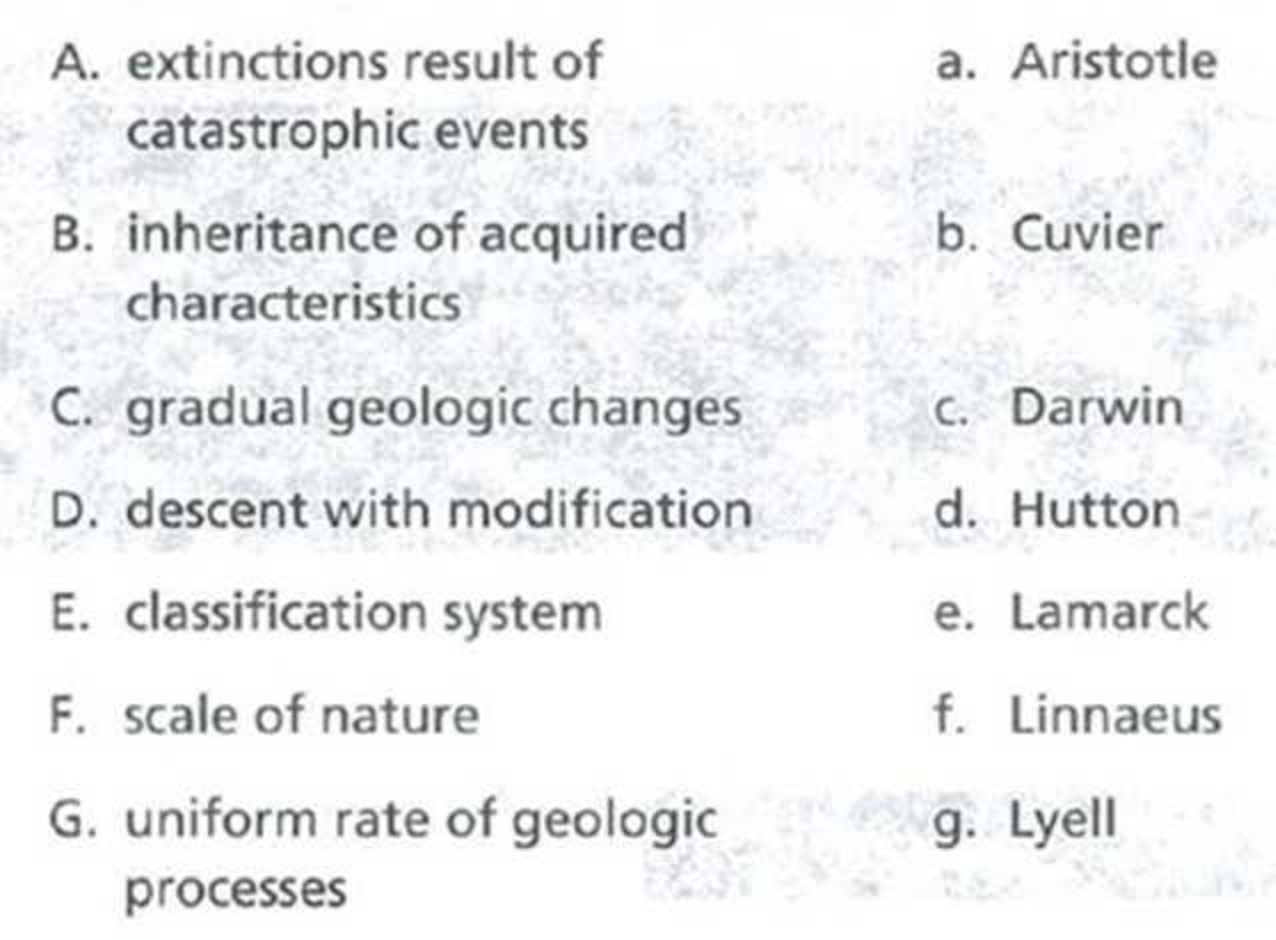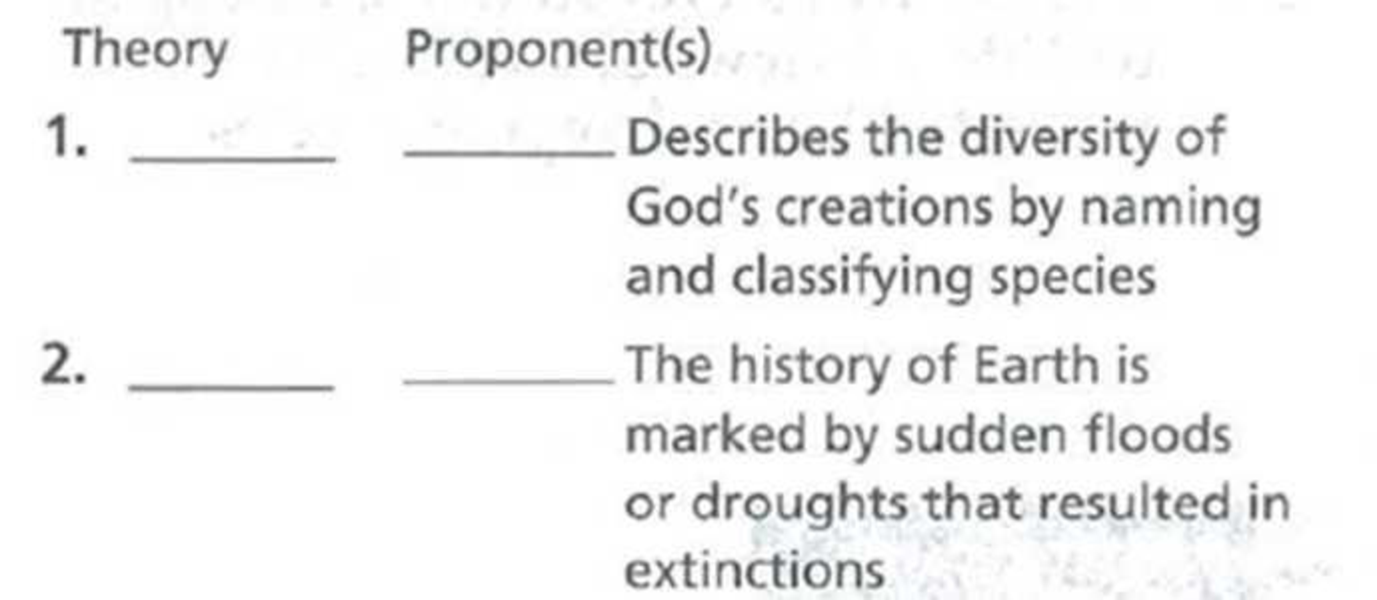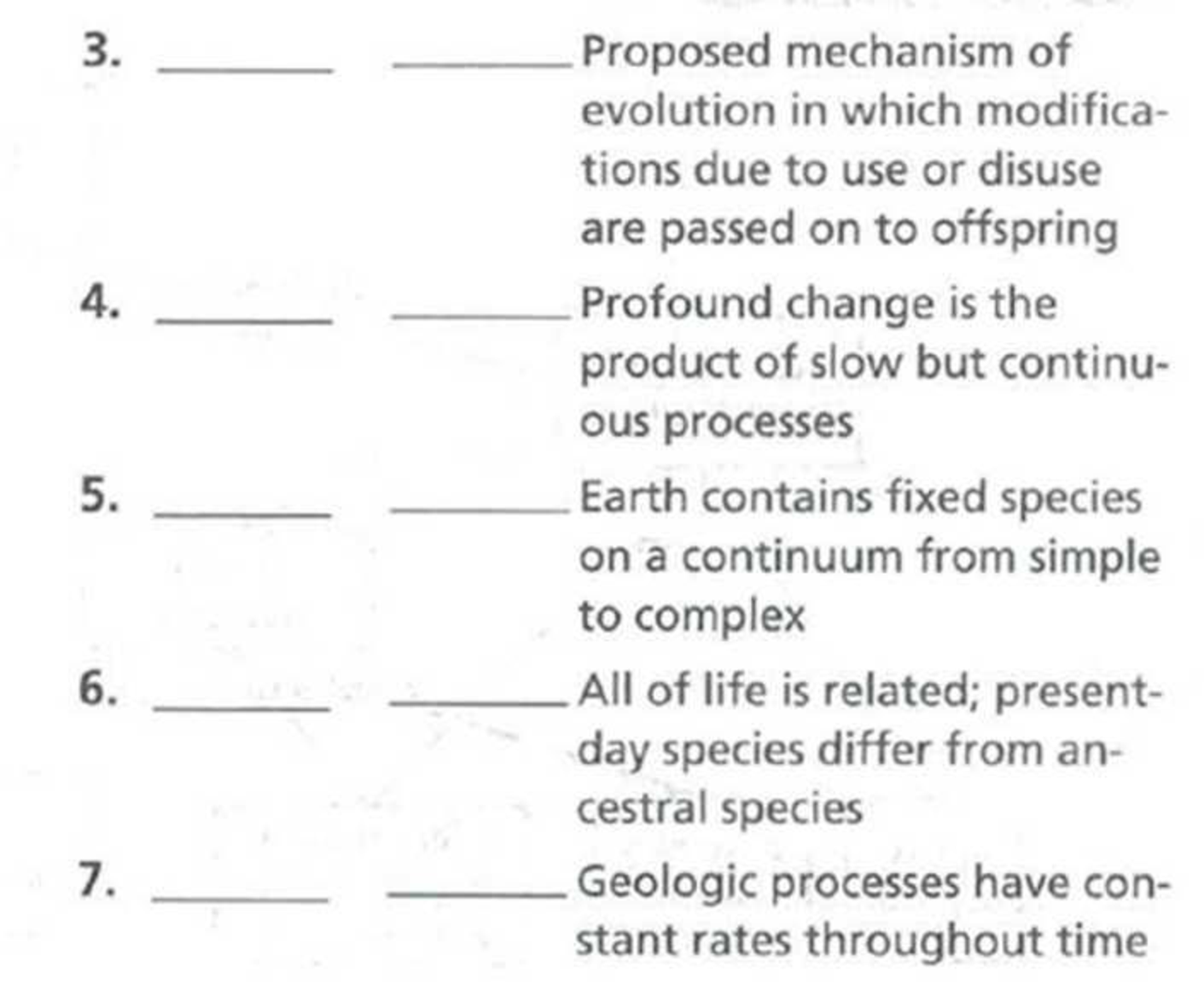
Concept explainers
- a. Write the capital letter representing the theory or philosophy and the lowercase letter(s) representing its proponent(s) in the blanks preceding the following seven descriptions.



- b. Now place the people listed in a through g in chronological order according to the dates of their ideas regarding change over time.
__________
a.
To match: The theory or philosophy with their respective proponents.
Introduction: Our earth was formed before 4.6 billion years from the sun with continuous bombardment of huge rocks and ice. When the Earth was formed, chemical evolution began, which formed organic molecules. Organic molecules led to evolution of protobionts.
Answer to Problem 1IQ
| S. No | Theory | Proponents |
| 1 | E. classification system | f. Linnaeus: Describes the diversity of God’s creations by naming and classifying species. |
| 2 | A. extinctions result of catastrophic events | b. Cuvier: The history of Earth is marked by sudden floods or droughts that resulted in extinctions. |
| 3 | B. inheritance of acquired characteristics | e. Lamarck: Proposed mechanism of evolution in which modification due to use or disuse are passed on to offspring. |
| 4 | C. gradual geologic changes | d. Hutton: Profound change is the product of slow but continuous processes |
| g. Lyell: Profound change is the product of slow but continuous processes | ||
| 5 | F. scales of nature |
a. Aristotle: Earth contains fixed species on a continuum from simple to complex |
| 6 | D. decent with modification | c. Darwin: All of life is related; present day species differ from ancestral species |
| 7 | G. uniform rate of geologic processes | g. Lyell: Geologic processes have constant rates throughout time |
Explanation of Solution
- 1. Classification system theory was proposed by Linnaeus. This theory describes the diversity of God’s creation by their different naming and classification of species.
- 2. Cuvier explained the philosophy that extinctions are the result of catastrophic events. He explained that extinctions and differences as the history of earth, those were marked by sudden catastrophic events. These are the indicatives of evolution.
- 3. Lamarck explained the mechanism of evolution by two principles. The two evolution principles are the use and disuse of body parts that leads to development or deterioration, and the inheritance of acquired characters.
- 4. Hutton and Lyell proposed the theory of gradual geologic changes. They explained the theory that profound changes occurs as per cumulative but continuous processes.
- 5. “Aristotle (384-322 BCE)” studied the closeness of different organisms and categorized them according to their nature of complexity. One of the significant observations by Aristotle was the shift of organisms from a simple state to a perfect state.
- 6. Darwin summarized his view of life in a phrase “descent with modification” in terms of unity and diversity. Sharing many characteristics by organisms made Darwin to observe unity in their lives. The unity in their lives was due to sharing common ancestors living in their remote past. Living in different habitats, these descendants gradually acclimatize to various modifications that enable them to adapt to specific environments.
- 7. Lyell proposed the theory of uniform rate of geologic processes. This theory explained that the geologic processes function at a constant rate and continue in the present.
b.
To place: The above listed people in a through g in chronological order as per the dates of their ideas regarding the change over time.
Introduction: Evolution is a process that has been taking place since the origin of life. Species have evolved themselves according to their needs with their changing surrounding environment. To explain these changes taking place in different species of plants and animals, different theories have been put forward from time to time.
Answer to Problem 1IQ
Correct answer: The correct chronological order for the people given is as follows:
Explanation of Solution
The chronological order as per the dates for the above listed people in a through g for their ideas regarding the change over time are as follows:
- Aristotle (384-322 BCE) proposed the theory of scales of nature.
- Then in the 1700s, Linnaeus developed the idea of binomial system of naming.
- Hutton proposed the theory of gradualism on 1795.
- Lamarck proposes the hypothesis of evolution on 1809.
- Cuvier on 1812 publishes his expensive studies of vertebrate fossils.
- Lyell proposes the theory of geological changes on 1830.
- Then the greatest phase of evolution, “descent with modification” invented by Darwin on 1844.
Want to see more full solutions like this?
Chapter 22 Solutions
Study Guide for Campbell Biology
Additional Science Textbook Solutions
Genetics: From Genes to Genomes
College Physics: A Strategic Approach (3rd Edition)
Chemistry: Structure and Properties (2nd Edition)
Laboratory Manual For Human Anatomy & Physiology
SEELEY'S ANATOMY+PHYSIOLOGY
Biology: Life on Earth with Physiology (11th Edition)
- Ch.21 What causes patients infected with the yellow fever virus to turn yellow (jaundice)? A. low blood pressure and anemia B. excess leukocytes C. alteration of skin pigments D. liver damage in final stage of disease — What is the advantage for malarial parasites to grow and replicate in red blood cells? A. able to spread quickly B. able to avoid immune detection C. low oxygen environment for growth D. cooler area of the body for growth — Which microbe does not live part of its lifecycle outside humans? A. Toxoplasma gondii B. Cytomegalovirus C. Francisella tularensis D. Plasmodium falciparum — explain your answer thoroughlyarrow_forwardCh.22 Streptococcus pneumoniae has a capsule to protect it from killing by alveolar macrophages, which kill bacteria by… A. cytokines B. antibodies C. complement D. phagocytosis — What fact about the influenza virus allows the dramatic antigenic shift that generates novel strains? A. very large size B. enveloped C. segmented genome D. over 100 genes — explain your answer thoroughlyarrow_forwardWhat is this?arrow_forward
- Molecular Biology A-C components of the question are corresponding to attached image labeled 1. D component of the question is corresponding to attached image labeled 2. For a eukaryotic mRNA, the sequences is as follows where AUGrepresents the start codon, the yellow is the Kozak sequence and (XXX) just represents any codonfor an amino acid (no stop codons here). G-cap and polyA tail are not shown A. How long is the peptide produced?B. What is the function (a sentence) of the UAA highlighted in blue?C. If the sequence highlighted in blue were changed from UAA to UAG, how would that affecttranslation? D. (1) The sequence highlighted in yellow above is moved to a new position indicated below. Howwould that affect translation? (2) How long would be the protein produced from this new mRNA? Thank youarrow_forwardMolecular Biology Question Explain why the cell doesn’t need 61 tRNAs (one for each codon). Please help. Thank youarrow_forwardMolecular Biology You discover a disease causing mutation (indicated by the arrow) that alters splicing of its mRNA. This mutation (a base substitution in the splicing sequence) eliminates a 3’ splice site resulting in the inclusion of the second intron (I2) in the final mRNA. We are going to pretend that this intron is short having only 15 nucleotides (most introns are much longer so this is just to make things simple) with the following sequence shown below in bold. The ( ) indicate the reading frames in the exons; the included intron 2 sequences are in bold. A. Would you expected this change to be harmful? ExplainB. If you were to do gene therapy to fix this problem, briefly explain what type of gene therapy youwould use to correct this. Please help. Thank youarrow_forward
- Molecular Biology Question Please help. Thank you Explain what is meant by the term “defective virus.” Explain how a defective virus is able to replicate.arrow_forwardMolecular Biology Explain why changing the codon GGG to GGA should not be harmful. Please help . Thank youarrow_forwardStage Percent Time in Hours Interphase .60 14.4 Prophase .20 4.8 Metaphase .10 2.4 Anaphase .06 1.44 Telophase .03 .72 Cytukinesis .01 .24 Can you summarize the results in the chart and explain which phases are faster and why the slower ones are slow?arrow_forward
- Can you circle a cell in the different stages of mitosis? 1.prophase 2.metaphase 3.anaphase 4.telophase 5.cytokinesisarrow_forwardWhich microbe does not live part of its lifecycle outside humans? A. Toxoplasma gondii B. Cytomegalovirus C. Francisella tularensis D. Plasmodium falciparum explain your answer thoroughly.arrow_forwardSelect all of the following that the ablation (knockout) or ectopoic expression (gain of function) of Hox can contribute to. Another set of wings in the fruit fly, duplication of fingernails, ectopic ears in mice, excess feathers in duck/quail chimeras, and homeosis of segment 2 to jaw in Hox2a mutantsarrow_forward
- Essentials Health Info Management Principles/Prac...Health & NutritionISBN:9780357191651Author:BowiePublisher:Cengage
- Case Studies In Health Information ManagementBiologyISBN:9781337676908Author:SCHNERINGPublisher:Cengage
 Medical Terminology for Health Professions, Spira...Health & NutritionISBN:9781305634350Author:Ann Ehrlich, Carol L. Schroeder, Laura Ehrlich, Katrina A. SchroederPublisher:Cengage Learning
Medical Terminology for Health Professions, Spira...Health & NutritionISBN:9781305634350Author:Ann Ehrlich, Carol L. Schroeder, Laura Ehrlich, Katrina A. SchroederPublisher:Cengage Learning Comprehensive Medical Assisting: Administrative a...NursingISBN:9781305964792Author:Wilburta Q. Lindh, Carol D. Tamparo, Barbara M. Dahl, Julie Morris, Cindy CorreaPublisher:Cengage Learning
Comprehensive Medical Assisting: Administrative a...NursingISBN:9781305964792Author:Wilburta Q. Lindh, Carol D. Tamparo, Barbara M. Dahl, Julie Morris, Cindy CorreaPublisher:Cengage Learning





